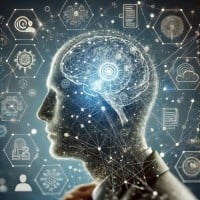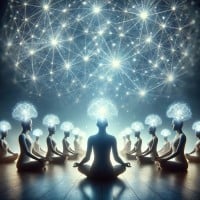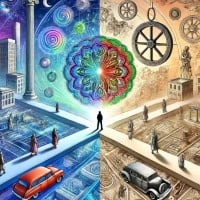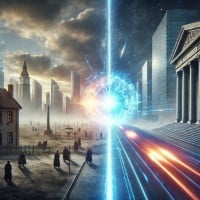Top 10 Most Likely Explanations for The Mandela Effect
Welcome to the strange world of the Mandela Effect, where shared memories clash with established facts, leaving us questioning the very nature of reality. This isn't just about fuzzy recollections of childhood favorites. Thousands of people swear Nelson Mandela died in prison in the 1980s (he passed in 2013). Others distinctly recall Pikachu's tail having a black tip (it's always been yellow).These collective false memories have sparked debates, conspiracy theories, and even scientific inquiry. Could it be proof of parallel universes? Time travelers meddling with the past? Or is there a simpler, more human explanation?
The Top Ten
1 False memories spread through social contagion and memory contamination
 False memories can be propagated among individuals through social interactions, leading to widespread misconceptions. When people discuss their memories, they can influence each other, causing details to be altered or completely fabricated. This process, known as memory contamination, occurs when the recollections of one person are adopted by another, even if inaccurate. Over time, these false memories become reinforced within a community, creating a collective belief in events that never occurred.
False memories can be propagated among individuals through social interactions, leading to widespread misconceptions. When people discuss their memories, they can influence each other, causing details to be altered or completely fabricated. This process, known as memory contamination, occurs when the recollections of one person are adopted by another, even if inaccurate. Over time, these false memories become reinforced within a community, creating a collective belief in events that never occurred.
 False memories can be propagated among individuals through social interactions, leading to widespread misconceptions. When people discuss their memories, they can influence each other, causing details to be altered or completely fabricated. This process, known as memory contamination, occurs when the recollections of one person are adopted by another, even if inaccurate. Over time, these false memories become reinforced within a community, creating a collective belief in events that never occurred.
False memories can be propagated among individuals through social interactions, leading to widespread misconceptions. When people discuss their memories, they can influence each other, causing details to be altered or completely fabricated. This process, known as memory contamination, occurs when the recollections of one person are adopted by another, even if inaccurate. Over time, these false memories become reinforced within a community, creating a collective belief in events that never occurred.
2 People organize information into schemas, or mental frameworks, and if a detail doesn't fit into our existing schema, we misremember it to make it fit
 The human brain relies on schemas, or mental frameworks, to organize and interpret information efficiently. When encountering details that do not align with these pre-existing schemas, individuals tend to adjust their memories to conform to what they expect. This cognitive process can lead to the alteration or distortion of memories, ensuring they fit into a familiar context. As a result, the modified memories seem more coherent but may deviate from the actual events.
The human brain relies on schemas, or mental frameworks, to organize and interpret information efficiently. When encountering details that do not align with these pre-existing schemas, individuals tend to adjust their memories to conform to what they expect. This cognitive process can lead to the alteration or distortion of memories, ensuring they fit into a familiar context. As a result, the modified memories seem more coherent but may deviate from the actual events.
 The human brain relies on schemas, or mental frameworks, to organize and interpret information efficiently. When encountering details that do not align with these pre-existing schemas, individuals tend to adjust their memories to conform to what they expect. This cognitive process can lead to the alteration or distortion of memories, ensuring they fit into a familiar context. As a result, the modified memories seem more coherent but may deviate from the actual events.
The human brain relies on schemas, or mental frameworks, to organize and interpret information efficiently. When encountering details that do not align with these pre-existing schemas, individuals tend to adjust their memories to conform to what they expect. This cognitive process can lead to the alteration or distortion of memories, ensuring they fit into a familiar context. As a result, the modified memories seem more coherent but may deviate from the actual events. The first three here are the only three that make any sort of sense whatsoever
3 False memories are formed through confabulation, a psychological phenomenon where people fill in gaps in their memories with fabricated details or fragments of information from other sources
Confabulation is a psychological phenomenon where individuals create false memories by filling in gaps with fabricated details or borrowed fragments from other sources. This often occurs unconsciously, as the brain attempts to construct a complete and coherent narrative. Over time, these invented elements can become indistinguishable from true memories, leading to a confident but inaccurate recollection of events. This process demonstrates how memory is not always a reliable record of the past.
4 Humans are connected by a shared consciousness or "morphic field" that can shape and influence our collective memories
 Some theories suggest that humans are linked by a shared consciousness or "morphic field" that can influence and shape collective memories. According to this idea, memories are not just stored in individual brains but are part of a larger, interconnected network. This shared field can supposedly cause groups of people to remember events in a similar way, even if those events did not happen as recalled. This concept posits that collective memory can be fluid and influenced by a greater, shared consciousness.
Some theories suggest that humans are linked by a shared consciousness or "morphic field" that can influence and shape collective memories. According to this idea, memories are not just stored in individual brains but are part of a larger, interconnected network. This shared field can supposedly cause groups of people to remember events in a similar way, even if those events did not happen as recalled. This concept posits that collective memory can be fluid and influenced by a greater, shared consciousness.
 Some theories suggest that humans are linked by a shared consciousness or "morphic field" that can influence and shape collective memories. According to this idea, memories are not just stored in individual brains but are part of a larger, interconnected network. This shared field can supposedly cause groups of people to remember events in a similar way, even if those events did not happen as recalled. This concept posits that collective memory can be fluid and influenced by a greater, shared consciousness.
Some theories suggest that humans are linked by a shared consciousness or "morphic field" that can influence and shape collective memories. According to this idea, memories are not just stored in individual brains but are part of a larger, interconnected network. This shared field can supposedly cause groups of people to remember events in a similar way, even if those events did not happen as recalled. This concept posits that collective memory can be fluid and influenced by a greater, shared consciousness.
5 A time travel event has altered the past, causing changes in the present that conflict with people's existing memories
One explanation for the Mandela Effect is the notion that a time travel event has altered the past, leading to discrepancies between current reality and people's memories. According to this theory, changes made in the past could create a present that differs from the one remembered by individuals. These alterations would result in conflicting recollections, as people retain memories from an unaltered timeline. This hypothesis suggests that our reality is subject to change through interventions in the past, affecting collective and individual memories.
6 There are multiple realities or timelines and the Mandela Effect is the result of people crossing over from one reality to another
 The theory of multiple realities or timelines suggests that the Mandela Effect occurs because individuals shift between different parallel universes. According to this idea, each universe has its own unique history and set of events. When people move from one reality to another, their memories from the previous timeline remain, leading to discrepancies between their recollections and the current reality. This crossing over can cause collective confusion as groups of people recall different versions of the same events.
The theory of multiple realities or timelines suggests that the Mandela Effect occurs because individuals shift between different parallel universes. According to this idea, each universe has its own unique history and set of events. When people move from one reality to another, their memories from the previous timeline remain, leading to discrepancies between their recollections and the current reality. This crossing over can cause collective confusion as groups of people recall different versions of the same events.
 The theory of multiple realities or timelines suggests that the Mandela Effect occurs because individuals shift between different parallel universes. According to this idea, each universe has its own unique history and set of events. When people move from one reality to another, their memories from the previous timeline remain, leading to discrepancies between their recollections and the current reality. This crossing over can cause collective confusion as groups of people recall different versions of the same events.
The theory of multiple realities or timelines suggests that the Mandela Effect occurs because individuals shift between different parallel universes. According to this idea, each universe has its own unique history and set of events. When people move from one reality to another, their memories from the previous timeline remain, leading to discrepancies between their recollections and the current reality. This crossing over can cause collective confusion as groups of people recall different versions of the same events.
7 Humans are living in a computer simulation and the Mandela Effect is a glitch in the simulation's programming
Another explanation posits that humans exist within a computer simulation, and the Mandela Effect is a result of glitches or errors in the simulation's code. These programming faults can alter details of reality, leading to inconsistencies between what people remember and the present state of the world. Such glitches can cause widespread false memories, as the simulation's updates or patches fail to synchronize perfectly with human recollections. This theory suggests that our perceived reality is artificial and prone to occasional malfunctions.
8 Through retrocausality, a newer event affects an earlier event causing a change in history without changing the memories of the event
 The concept of retrocausality involves future events influencing the past, leading to alterations in historical occurrences while preserving original memories. According to this theory, an event in the present can change an earlier event without affecting individuals' recollections of how things used to be. This can create situations where collective memories conflict with the current reality, as past events are modified after the fact. Retrocausality suggests that time is not linear and can be influenced from both directions.
The concept of retrocausality involves future events influencing the past, leading to alterations in historical occurrences while preserving original memories. According to this theory, an event in the present can change an earlier event without affecting individuals' recollections of how things used to be. This can create situations where collective memories conflict with the current reality, as past events are modified after the fact. Retrocausality suggests that time is not linear and can be influenced from both directions.
 The concept of retrocausality involves future events influencing the past, leading to alterations in historical occurrences while preserving original memories. According to this theory, an event in the present can change an earlier event without affecting individuals' recollections of how things used to be. This can create situations where collective memories conflict with the current reality, as past events are modified after the fact. Retrocausality suggests that time is not linear and can be influenced from both directions.
The concept of retrocausality involves future events influencing the past, leading to alterations in historical occurrences while preserving original memories. According to this theory, an event in the present can change an earlier event without affecting individuals' recollections of how things used to be. This can create situations where collective memories conflict with the current reality, as past events are modified after the fact. Retrocausality suggests that time is not linear and can be influenced from both directions.
9 Deliberate manipulation of information by powerful entities or organizations
Some believe that powerful entities or organizations deliberately manipulate information, causing the Mandela Effect. This theory suggests that these groups alter records, media, and historical data to shape public perception and control collective memory. By modifying details and spreading false information, they create inconsistencies between what people remember and the current accepted facts. This deliberate tampering with information can lead to widespread confusion and false memories.
10 Aliens, interdimensional beings, or spiritual entities altered people's memories to conceal their presence
Another explanation for the Mandela Effect is that aliens, interdimensional beings, or spiritual entities have tampered with human memories to hide their existence. These entities might have the power to manipulate minds, erasing or altering recollections to maintain their secrecy. As a result, people experience conflicting memories that do not align with current reality. This theory implies that supernatural forces are actively involved in shaping human perception and memory.
BAdd New Item